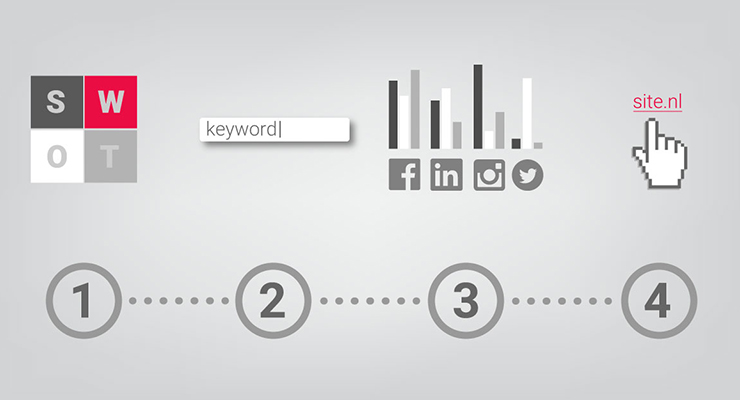Guest blog: Competitive analysis in 4 steps

SQR.NL offers its partners the opportunity to write a guest blog about their services. The story is the partner’s own and gives an inside look at what they are doing or what they can offer. Terence Punt of Specialist in Websites kicks off with a story on competitive analysis.
Conduct an online competitive analysis in 4 steps.
How does your business rank against online competition? Are you getting the maximum return from your online channels? Can’t get to the answer within 30 seconds? Then it’s time to conduct an online competitive analysis.
In online competitive analysis, you conduct research on your competitors with the goal of improving yourself. In particular, this analysis focuses on keywords, social media and links. Of course, you can borrow ideas from competitors, but always make sure you remain unique.
1. Make a SWOT analysis
You can perform a competitive analysis only if you have comparative material: a so-called benchmark. Therefore, start by brainstorming and preparing a SWOT analysis of your own business. To do this, map out your own strengths and weaknesses. Then you start looking for opportunities and threats within your (online) environment. During the SWOT analysis, you do the same for your competition.
2. Conduct a keyword analysis
Are you being found on key search terms? What keywords are your competitors actually being found on? Are there any keywords you don’t already use?
The easiest way to perform a keyword analysis is to simply type the desired keyword into Google. You can then immediately see which parties are at the top with that keyword. In the Google Maps view, you can instantly see competitors’ physical locations. At the bottom of the search results page you will find a section with “searches related to {chosensearch term}. A great resource for inspiration, but with 8 keyword ideas per search, it’s still a bit sparse.
If you have a Google Ads account, you can also use the Google Keyword Planner. Enter the desired keyword and you will get an overview of search volumes, degree of competition on that keyword and the estimated cost per click for advertising. A good source of inspiration, but in our view not yet always complete enough.
For more extensive research, you can use Ubersuggest. Simply enter your desired keyword, choose your language and let the tool do the work for you.
You get instant insight into your chosen keyword. Ubersuggest gives you an instant overview of the questions you have, such as:
- How many times is this keyword searched per month?
- How big is the competition on this keyword?
- What are my chances of getting into the top 10 with this keyword?
- How much will I pay per click if I want to advertise?
- Who are my main competitors and how well does their website rank?
On our site you will find another blog with a more detailed article on how to conduct a complete keyword research.
3. How active are you on social media?
![]()
Social media is ideally suited to get your message across. So go figure: what is the competitor doing on social media? Look around on platforms such as Facebook, Instagram, YouTube, Snapchat or Pinterest. Map out some answers for yourself:
- Why is my competitor (not) using this platform?
- What tone-of-voice is my competitor using?
- How often is it posted? At what times?
- How are images and text used?
- What kind of posts get the most likes?
- How does interaction with followers take place? Is there an active response?
After answering these questions, you will have a fairly complete picture of your competition’s interpretation of social media as a marketing tool. With this information, you can make a good assessment of the efforts needed to build your own social strategy and crush the competition.
4. Look for good links
An important ranking factor within Google is the number of backlinks pointing to a Web site. Backlinks include all links that link to your website from other websites.
If you get many referrals from websites with high authority, such as The Nutrition Center or the ANWB, then Google will also find your website more trustworthy. In general, home pages or other sites with lots of outbound links are seen by Google as spam with little added value. Therefore, a link from such a page will diminish your authority and, if used excessively, Google may even give you a penalty. When link building, always go for quality over quantity!
Through a free online backlink checker, you can quickly find out where your biggest competitors are getting their (most important) links from. Look for the best possible links for you and feel free to contact the owner of the website in question for link placement. After all, the competitor did the same thing!
Another common tactic is guest blogging, in which you write an article about your expertise on a relevant website. In this article, you then incorporate a link to your own website. This will prevent Google from seeing your link profile as spammy.
On to the result!
After this competitive analysis, you now have a complete overview of your own company’s online strategy and the competition. You know which keywords are important in the market, how competitors are using their social media and where to get valuable links. With this comprehensive SWOT analysis, you can begin to form your own strategy. Take advantage of your competition’s strengths, but also definitely its weaknesses!
